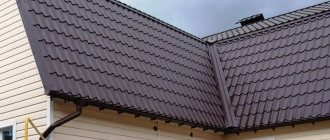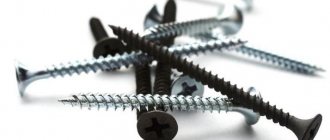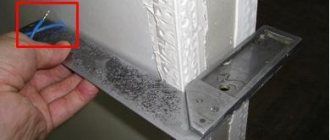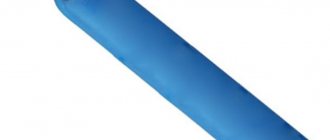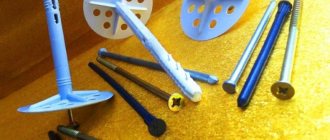Many builders who install metal tiles do not pay special attention to the accompanying elements of the roof covering, being mistaken and thinking that good quality roofing material is sufficient to achieve good results. Self-tapping screws for fastening metal tiles are just such related materials. How to fasten metal tiles using self-tapping screws, calculate the consumption of self-tapping screws for metal tiles and choose the right screws.
Roofing screws are an integral part of a strong, high-quality and durable roof.
When selecting self-tapping screws for roofing, you need to rely on quality products.
Self-tapping screws, in comparison with the roofing material, are subject to significantly greater loads not only during installation, but also during operation. Therefore, such seemingly insignificant details require a serious and balanced approach.
What types of self-tapping screws are there for roofing?
Roofing screws differ from ordinary ones in that they have a special sealing washer.
Depending on the load they will be subjected to, the following categories can be distinguished:
- Metal-metal.
- Wood-metal.
It is very important to strictly follow this classification and not use screws for other purposes.
Quite a lot of people believe that roofing screw washers will negatively affect the aesthetic appearance of the roofing. In fact, due to the fact that there are a huge number of colors of self-tapping screws on the market, you will definitely find those that will not stand out against the background, for example, metal tiles. So the screws will ensure a tight seal and will look perfect on the surface.
To obtain maximum tightness, the screws must be of sufficient quality. It is important to pay attention to the special markings that are present on the fastener head. As a rule, high-quality self-tapping screws are made of high-carbon or stainless steel. In addition, they must have an anti-corrosion coating.
It is worth noting that when using high-quality self-tapping screws, rust streaks will not appear at the fastening points of the metal tiles due to the onset of corrosion of the fasteners. The sealing rubber lining also plays an important role. Conscientious well-known manufacturers make washers for self-tapping screws from special EPMD rubber. They are characterized by better resistance to temperature changes, and they also have improved elasticity.
Features of self-tapping screws for metal tiles
The main difference between roofing screws and self-tapping screws, which are familiar to many, is that they have a special tip that can be easily screwed into the metal covering and into the sheathing, without the need for additional drilling of technological holes. In addition, the products are distinguished by the presence of a seal under the head. If we consider their structure, then self-tapping screws for metal tiles consist of the following elements:
- kernel;
- tip in the form of a drill;
- head;
- polymer coating of the head;
- neoprene gasket.
Each part performs its own functions, and the entire product has high performance characteristics. For example, the rod is made from galvanized steel, which is durable and resistant to corrosion. The thickness of the zinc layer must be at least 12 microns. The polymer coating is not just decorative, but also protects the head from external negative factors. The neoprene layer performs a sealing function and at the same time prevents the screws from being screwed in too tightly so as not to damage the top layer of the metal tile. The thickness of the gasket should be from 2 mm. The drill-shaped tip allows you to easily drill through metal sheets and wood decking. That is, such fasteners not only fix the covering, they give the roof a presentable appearance, and also protect the joints from the harmful effects of moisture. And these are not all possible positive qualities.
Quality of self-tapping screws and calculation of quantity - how much is needed
When purchasing self-tapping screws, it is advisable to check their quality, as this may affect the total consumption of self-tapping screws for metal tiles. The screw washers must fit tightly to the metal surface. Do not use fasteners in which the rubber washer can be easily separated from the screw. Over time, such an elastic band may collapse, resulting in water seeping into the fastening points and rusty stains appearing.
It is important to know how many screws are needed per sheet of metal tile, and you should also be able to distinguish low-quality fasteners from high-quality ones. To do this, squeeze the washer with pliers. On a bad screw, the protective layer will begin to crumble or come off. Manufacturers with a reputation will not allow this, since each of their fasteners undergoes all kinds of load tests.
Steel screws must meet the following requirements:
- When the self-tapping screw is repeatedly bent by 5 degrees in opposite directions, it must withstand 20,000 vibrations.
- When the inclination increases to 10 degrees, the self-tapping screw must pass the 2000 bend test.
- With a bend of 15 degrees, the number of bends should reach 100.
High-quality products will easily pass all tests while maintaining their structure.
Currently, an increasing number of trusted metal tile manufacturers are testing their products with suitable self-tapping screws. And only when using original self-tapping screws will you receive the offered warranty from the manufacturer. This way, you will know exactly how many screws you will need per sheet of metal tile. If you do everything as the manufacturer advises, then in the end the metal roofing covering will be able to last at least up to 50 years.
Characteristics and dimensions of roofing screws
It is important to know that on sale there are not only self-tapping screws for metal tiles that will be attached to wood, but also products that allow you to mount sheets to a metal or concrete base. That is, when choosing, be sure to clarify for which surfaces the product is intended. They can also be distinguished by their appearance. In particular, you should pay attention to the following signs:
- the large distance between the threads and the average size indicate that the self-tapping screw will reliably hold the coating on a wooden or other soft surface;
- a sharp tip, a frequent thread pitch and a medium size are signs of self-tapping screws for fastening to metal bases;
- Long-length self-tapping screws are designed for fastening additional elements, while they are also subdivided for fixing components to wood or metal.
Another characteristic is the shape of the screw head. Unlike conventional self-tapping screws, where the most common option is a round head, in roofing screws the head can be semicircular, hexagonal, spherical or cylindrical, and also differ in the type of slots - cross-shaped, square, figured, rectangular, star-shaped and so on. These parameters must be determined in advance in order to select the right tool or purchase self-tapping screws that would match the existing equipment.
In addition to the appearance characteristics, it is worth knowing what sizes are standard for self-tapping screws. So, the main parameters are as follows:
- length – 19 – 250 mm;
- diameter – 4.8 – 6.3 mm.
The smallest size is very rarely used for installing tiles, but is used to connect sheets together. The most common option is a screw with a length of 2.8 cm. This is the size that is needed to, having passed through the sheet of covering at the bottom of the wave, securely fix it to the sheathing under the metal tile. Of course, during installation it is important to know not only how to choose the size or shape of the screw, but also how many self-tapping screws per 1 m2 of metal tiles should be used. To understand this issue, it is worth learning how to calculate self-tapping screws.
Consumption of self-tapping screws
Before calculating the metal tiles for the roof, many are interested in how many screws are needed for the metal tiles in order to obtain the most reliable fastening. The overwhelming number of experts claim that up to 8-10 pieces of roofing screws should be screwed in per 1 m2 of roofing material. This amount applies to regular sheets. Where there are complex curves of the roof, as well as based on the thickness of the metal and the width of the roof purlins, the calculation of self-tapping screws for metal tiles will be different.
It is worth noting that the roof covering must be attached to the wooden sheathing using 4.8×35 wood-to-metal screws.
Fastening production
It is necessary to fasten each sheet of tile with self-tapping screws to the sheathing in its lower part, in places where there is a tight junction. For this task, it is best to use metal roofing screws. They should be fixed below the step, which is a guideline in our work, by a couple of centimeters.
When screwing in the screws, the rubber gasket should deform and tightly close the space between the roof and the washer. Thanks to the vulcanizing properties of the gasket, you should get a tight connection. For such work, the most suitable self-tapping screws will be self-tapping screws with a length of at least 28 mm.
To carry out the work correctly, you will need an electric screwdriver.
Tips for securing metal tile sheets
All lower edges of the metal tile sheet are fixed with self-tapping screws into the base of the wave. Next, the screws need to be screwed in in increments of two waves, and it is better to place the fastening places of the screws in the rows in a checkerboard pattern.
It is worth considering that after laying the side sheet of metal tile overlapping, screw the screws into the ridge from each wave. Secure the end strip with self-tapping screws at intervals of 50-60 cm. Fix the ridge strip with special self-tapping screws for ridges through each wave of the metal tile.
You can determine the number of screws for metal tiles after creating a roofing project, when all the dimensions and volume of the roofing covering are available, and all complex elements of the frame structure are taken into account.
Remember that by purchasing high-quality fasteners, you will receive a reliable, powerful roof that can serve you for decades.
Scheme of fastening metal tiles with self-tapping screws
Fastening metal tiles with self-tapping screws according to the scheme guarantees a strong and reliable roof. On the edges of the slopes in the outer rows, the number of fastenings increases.
Important! If sheets have to be cut, then you need to use special disc shears. When cutting with a grinder, the protective polymer coating melts and loses its properties.
Manufacturers provide the mounting procedure on their web pages and describe them in the instructions. The number of attachment points and their spacing at the edge of the slope and in its middle are determined there.
A little about metal tiles and self-tapping screws
This roofing material is extremely popular in Russia today. This is primarily due to its durability, low price and ease of installation. It competes only with flexible slate and its traditional asbestos-cement analogue.
The metal tiles are attached to the wooden sheathing with special self-tapping screws. They are noticeably different from other mounts in appearance. So:
- instead of the usual sharp tip, they have a drill that allows you to easily penetrate the metal of the roofing material;
- the cap has a hexagonal shape;
- It is also equipped with a rubber seal, which ensures a tight fit and tightness.
In order not to spend extra money on fasteners, you need to understand exactly in what order and quantity they are screwed into a profiled steel sheet. In addition, this allows you to avoid mistakes, in particular unnecessary holes, which are extremely difficult to repair.
Features of installing hidden fastenings
Metal tiles with hidden fastening have some installation features that must be taken into account. The fastening elements of such metal tiles are a self-tapping screw and a press washer. Since the system is designed in such a way that the fastening point is not visible from the surface (it is covered by the next sheet), screws made of galvanized steel can be used. It is not necessary to use fasteners whose caps are painted the same color as the metal tiles. The sheets are fastened to each other by engaging all the mounting protrusions and grooves located on the edges of the sheets. The place where the sheet is fastened with self-tapping screws is hidden during installation of the next sheet. Thus, there are no fastenings or through holes on the surface. This fastening makes it possible to create an ideal roof covering, characterized by absolute tightness. The service life of a metal tile roof with hidden fastening is very long.
Tools and materials for installation
When carrying out roofing work, it should be taken into account that they will be carried out at a fairly significant height and what seemed like a simple technological action on the ground will be very difficult to perform at a level of 5-10 meters.
Tools for installing metal tiles.
All tools used must be kept in a place where they will not fall and used only when necessary. If a hammer or screwdriver falls to the ground, you will have to go down to get it, wasting valuable time.
To work you will need a standard set of tools:
- tape measure for measuring the distance between screws;
- marker;
- hammer;
- electric screwdriver or drill with slow speed function;
- a tool for cutting metal sheets - a metal saw, an electric jigsaw or a carbide circular saw.
Choosing high-quality self-tapping screws
The design of self-tapping screws created specifically for metal tiles allows them not only to easily overcome the resistance of steel, but also to be securely held in wooden
designs. To prevent fasteners from rusting, a special anti-corrosion layer is applied to them at the plant. Most often, galvanic galvanizing is used - this method creates an almost indestructible bond between the top layer and the base.
All self-tapping screws are now produced in various colors that match the main palette supplied to the metal tile market. For this reason, their caps are almost invisible on the finished roof.
Most companies that manufacture the previously mentioned coating also produce self-tapping screws for it. These are the ones you should choose when purchasing everything you need for the roof. The thing is that only when using “original” products do companies provide a guarantee for the roof. Third-party consumables are grounds for refusal to fulfill obligations.
As previously noted, the tightness of the fastening is largely ensured by a rubber seal installed under the cap. Today, self-tapping screws are often supplied with polymer gaskets. By and large, the durability of the roof as a whole directly depends on the quality of this part. Cheap options are usually destroyed quite quickly by heat and dampness - as a result, water gets under the metal tiles and leaks appear. Moreover, excess moisture, falling on the unprotected end of the roofing material, leads to the formation of rust, which in just a few years can “eat out” a rather large hole in a seemingly new roof.
If you nevertheless decide to purchase fastening elements separately from the roofing material, make sure that the alternative ones are made of the proper quality. The manufacturer usually puts markings on good self-tapping screws, but cheap counterfeits do not have them.
Only high-carbon steel is used for the production of fasteners. And a certain number of them from each batch undergo mandatory and very thorough testing. Responsible manufacturers claim that the service life of their self-tapping screws is half a century.
The main indicator of fastener quality is the reliability of the protective layer.
If you squeeze a bad screw with pliers, the zinc will peel off from it. A high-quality coating will remain in place. The thickness of all fasteners for metal tiles is the same - 4.8 millimeters, but the length can be different. Supplied in particular:
- 20mm;
- 35;
- 50;
The first two positions are used to fix the sheets to the sheathing. Longer ones are used where the most reliable contact is needed - along the edges of the roof, on the ridge, in the valleys.
Calculation of self-tapping screws
When designing a future roof, you should pay attention to every little detail, including the consumption of screws. If fasteners are used frequently, there is a high probability of leakage in the future. If you use a minimum of hardware, then the metal tiles will vibrate when there are gusts of wind, and this will lead to rapid destruction of the roof.
To correctly calculate the required number of screws, you need to know 2 parameters:
- Density of fasteners per 1m2;
- Roof area.
Sheets of metal are attached to the sheathing. In this case, the hardware passes at the bottom of the wave, which rests on the wood. Experienced builders know that under no circumstances should fasteners be passed along the top of the wave. Fastening of metal tiles in the area of the ridge and the outer part of the roof should occur in each wave.
At intermediate stages, hardware must be placed through the wave. In places of overlap, the interval between fastenings should be 1 meter along the sheathing. With an average sheathing pitch of 50 cm per 1m2, you need to use 7 screws.
Remember, properly secured finishing material can last a long time. The required number of fasteners should be used. They will ensure reliable fixation of the metal tiles.
Screws for metal tiles
It is a fairly common opinion that when planning the installation of a roof made of metal tiles or corrugated sheets, special attention should be paid only to the coating itself, and as for the components, you can purchase any. However, such an attitude towards fixing elements can lead to the fact that the roof will lose its reliability and aesthetics in the very near future. After all, it is the fasteners that are responsible for the strength of the decorative coating and its durability. At the same time, it is recommended to choose only special hardware designed specifically for flooring based on metal sheets, which includes metal tiles. Screws for metal tiles are called roofing screws, since they are made for a specific purpose - to fasten sheets of metal tiles to the roofing pie. Such products differ in quality, shape, size, and are not always supplied complete with roof decking. Therefore, when buying products, it is worth knowing which options are best suited for solving certain problems, as well as how to calculate the required number of screws for a specific roof.
